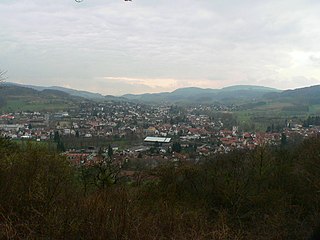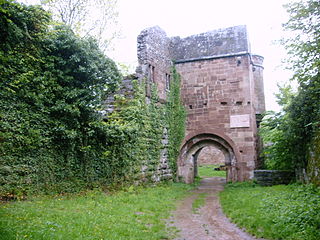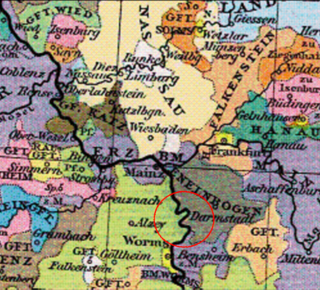
The Odenwald is a low mountain range in the German states of Hesse, Bavaria and Baden-Württemberg.
The Odenwaldkreis is a Kreis (district) in the south of Hesse, Germany. Neighboring districts are Darmstadt-Dieburg, Miltenberg, Neckar-Odenwald-Kreis, Rhein-Neckar-Kreis and Kreis Bergstraße. Odenwaldkreis belongs to the Rhine Neckar Area.
Groß-Gerau is a Kreis (district) in the south of Hesse, Germany. Neighboring districts are Main-Taunus, district-free Frankfurt, Darmstadt-Dieburg, Bergstraße, Alzey-Worms, Mainz-Bingen, and the district-free cities Mainz and Wiesbaden.

Reichelsheim (Odenwald) is a municipality in the Odenwaldkreis (district) in Hesse, Germany.

Groß-Umstadt is a town in the district of Darmstadt-Dieburg in the Bundesland of Hesse in Germany. It is near by Darmstadt and Frankfurt on the northern border of mountain range Odenwald and is on the south-eastern edge of Rhine-Main Metropolitan Region.

Michelstadt in the Odenwald is a town in the Odenwaldkreis (district) in southern Hesse, Germany between Darmstadt and Heidelberg. It has a population of 28,629 people.

Höchst im Odenwald is a municipality in the Odenwaldkreis (district) in Hesse, Germany.

Bad König is a town and resort (Kurort) in the central Odenwald in the Odenwaldkreis (district) in Hesse, Germany, 29 km southeast of Darmstadt.

Mömlingen is a municipality in the Miltenberg district in the Regierungsbezirk of Lower Franconia (Unterfranken) in Bavaria, Germany.

Kirchzell is a market community in the Miltenberg district in the Regierungsbezirk of Lower Franconia (Unterfranken) in Bavaria, Germany.

Frankenstein Castle is a hilltop castle in the Odenwald overlooking the city of Darmstadt in Germany. This castle may have been an inspiration for Mary Shelley when she wrote her 1818 Gothic novel Frankenstein; or, The Modern Prometheus.

Brensbach is a municipality in the Odenwaldkreis (district) in Hesse, Germany.

Fränkisch-Crumbach is a municipality in the Odenwaldkreis (district) in Hesse, Germany.

Lützelbach is a municipality in the Odenwaldkreis (district) in Hesse, Germany.

The House of Franckenstein is the name of a feudal, Franconian noble family in Germany, descendants from the Dynasts of the Breuberg family; offsprings of the Lords of Lützelbach from Höchst im Odenwald.

The Mümling is a river of Hesse and Bavaria, Germany. It is 49.7 kilometres (30.9 mi) long and lends its name to the Mümlingtal in Odenwald. In Bavaria it is sometimes called Mömling in official documents. It is a left tributary of the Main.

The Neckar-Odenwald Limes is a collective term for two, very different early sections of the Upper Germanic-Rhaetian Limes, a Roman defensive frontier line that may have been utilised during slightly different periods in history. The Neckar-Odenwald Limes consists of the northern Odenwald Limes (Odenwaldlimes), a cross-country limes with camps, watchtowers and palisades, which linked the River Main with the Neckar, and the adjoining southern Neckar Limes (Neckarlimes), which in earlier research was seen as a typical 'riverine limes', whereby the river replaced the function of the palisade as an approach obstacle. More recent research has thrown a different light on this way of viewing things that means may have to be relativized in future. The resulting research is ongoing.

Wildenberg Castle, also called the Wildenburg, is a ruined, Hohenstaufen period castle in the Odenwald hills in Germany. It is located in the parish of Preunschen in the municipality of Kirchzell, in the Lower Franconian district of Miltenberg in Bavaria.

The House of Breuberg is the name of a dynastic, franconian, noble family in Germany, descendants from the Lords of Lützelbach.

The Lordship of Franckenstein was a historical territory in the northern Odenwald. It originated around 1230 from the possessions of the Breuberg, whose center was Frankenstein Castle. Konrad II of Breuberg and his wife Elisabeth of Weiterstadt called themselves Frankenstein after having build the castle henceforth. The dominion remained as condominium in the possession of the family until the year 1662. After the sale by the Frankensteis to Landgrave Louis VI, Landgrave of Hesse-Darmstadt, it came into the possession of Hesse-Darmstadt.

























